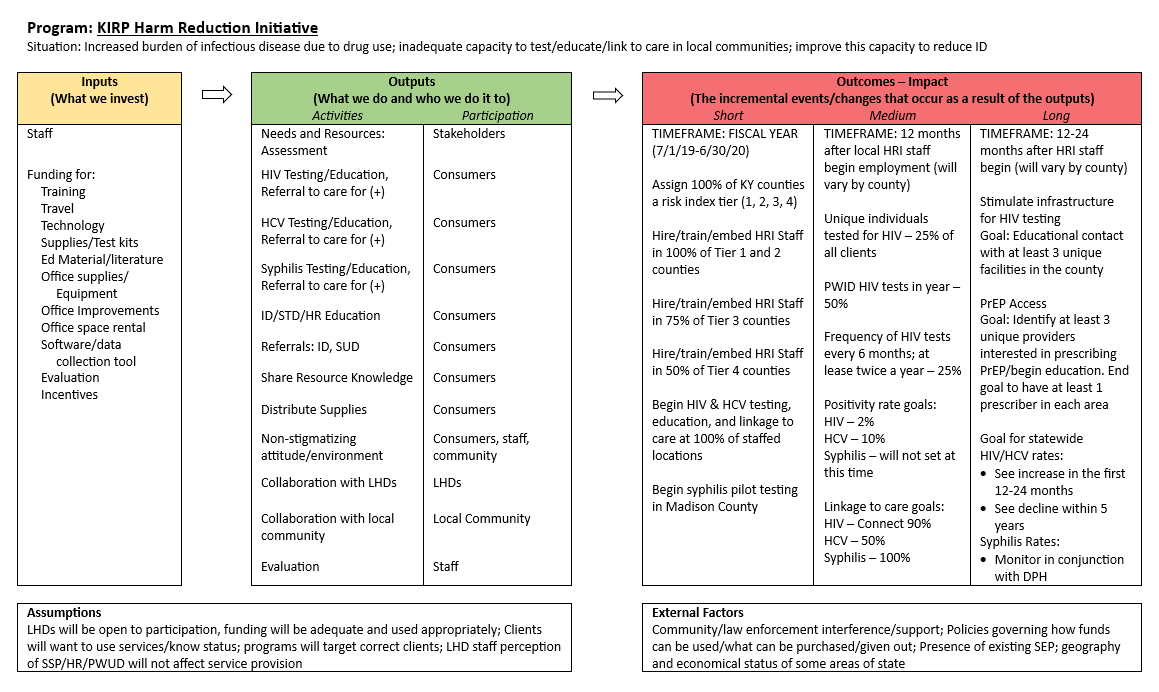With the evaluation team and the evaluator in place, the next step in the planning process is to ensure that everyone has a working understanding of what your harm reduction program goals and objectives are, and how your program activities contribute to meeting those objectives. You can think of program goals as the overarching purpose or mission of your program. It is the statement that defines why you are doing what you are doing. Here is an example of a harm reduction program goal.
Objectives are the ways that you plan to accomplish your program goal. Objectives can be as specific as a single quantitative change, or more complex, such as establishing a new service to reach your program goals. Here are some examples of program objectives for the above goal.
There are typically no limits to the number of program goals and objectives. Your harm reduction program can have one goal or multiple goals, and each goal can have multiple objectives. Some goals are built into every harm reduction program, such as “improve safety and quality of life for PWUD,” but your program should also include goals specific to your context and community. Using your program goals and objectives to frame your evaluation design ensures that your program evaluation effort is accurately assessing the results of your program’s activity.
One way to visually depict how your program activities are tied to your goals and objectives is to develop a logic model. A logic model can offer the evaluator and the evaluation team a clear picture of your harm reduction program’s goal and key elements of the program’s activities, insight on how the program operates, and an overview of intended outcomes. This can be a particularly helpful tool to share with those on your evaluation team who are not familiar with the specifics of your harm reduction program work or with an external evaluator.

WHAT IS A LOGIC MODEL?
“A logic model is a visual depiction of all of the program activities, outcomes and outputs. It is essentially a tool that shows how a program proposes to solve a problem or achieve a goal. It is a helpful step in making sure your program and your evaluation effort remain both purposeful and organized.”
Table (3.3) Logic Model Components and Descriptions
| Program Goal | The target or outcome that the program is trying to reach; often tied to the funding stream and/or mission of the organization. |
|---|---|
| Inputs | The staffing, resources, supplies, and time that goes into your harm reduction program. |
| Activities | What your program is doing to accomplish your program goals; the program’s efforts. |
| Outputs | What is produced or happens because of the activities; can be referred to as impact or outcomes. |
| Short-Term Outcomes | The intended difference the program activities should make within the organization or the community at large in the short term. |
| Intermediate (Medium) Outcomes | The intended difference the program activities should make within the organization or the community at-large in the longer term. |
| Long-Term Outcomes (Impact) | The target or outcome that the program is trying to reach; often tied to the funding stream and/or mission of the organization. Same as the program goal. |
| Assumptions | What you expect to be true about your program, program activities, and participants. |
| External Impacts | The environmental context that will likely influence program activities. |
Source: Developing an effective evaluation plan: Setting the course for effective program evaluation by CDC
Below is an example of a logic model that was developed by the Oregon Harm Reduction Initiative using the framework above:

Source: SSP Manual by Oregon Health Authority
If you are new to developing logic models or are interested in a refresher, here are some resources: